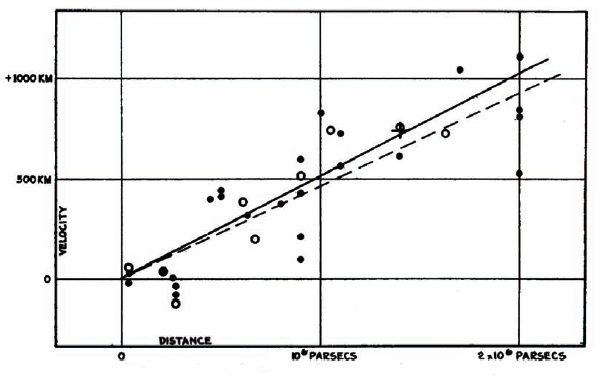Universe is Expanding
"Red Shift" is Proof of Einstein's General Theory
Using the 100-inch Hooker Telescope at Mount Wilson Observatory, Dr. Edwin Hubble has studied many spiral nebulae. He has discovered they are moving away from us at a rapid pace. This is strong evidence of an expanding universe. He has further determined that the farther the nebula, the faster it moves away.
Hubble and colleague Milton Humason measured the speeds and distances for twenty-four of these nebulae. Because they are moving so quickly, their light waves (electromagnetic spectra) are stretched out. Because red light has the longest wavelength, this phenomenon is known as "redshift". The team noticed that dimmer, more distant objects have a larger redshift than objects closer to Earth. As reported in a recent paper, Hubble's measurements led him to a useful speed-distance relationship: redshifts increase in direct proportion to their distance from us.

Image credit: Hubble, PNAS, 15, 3 (1929)
Hubble's graph of redshift versus distance.
Dr. Hubble determined distances to the twenty-four nebula using Cepheid variable stars. These are stars that astronomers use to determine the distance to the nebulae they are found in. Once he knew how far away the nebulae were, he could compare their distance to their red-shift to learn the relationship. He concluded that the most distant objects are speeding away from us at perhaps thousands of miles per second.
Dr. Hubble's recent discoveries show that the volume of space itself is expanding. Spiral nebulae appear to be moving away from each other at a rate that increases with distance, but these nebulae aren't just moving. They are being pulled along as space expands.
Hubble's findings build on the work of Dr. Vesto M. Slipher of Lowell Observatory in Flagstaff, AZ. In 1912, Dr. Slipher first recorded the electromagnetic spectra of spiral nebulae. All but a few of the forty spectra Slipher later gathered were very red-shifted. This means almost all of them were moving away from us. However his studies lead him to a conclusion that speeds for the nebulae might be closer to only 600 miles per second.
Although Hubble's work presents a big breakthrough in our understanding of the Universe, one big question remains. How far out into the Universe does his model hold? The 100-inch telescope can clearly show Cepheids in only the nearest nebulae. In very distant nebulae, where Cepheids are barely visible, Hubble uses the brightest individual stars, some 50 to 100 times brighter than the Cepheids, as standard candles.
Today's telescopes, and the stars they see, will only take Dr. Hubble so far. To measure even greater distances, astronomers will need a larger telescope and new types of standard candles.
One new instrument may hold the key. Last year the Rockefeller Foundation agreed to provide six million dollars to fund the construction of a new observatory with a 200-inch telescope. This new telescope will collect four times more light than the 100 inch telescope Hubble currently uses.
Einstein's General Theory Holds True
The past decade has been an exciting and challenging time in the development of scientific understanding of the Universe. During this time scientists have been testing their ideas about the Universe against Einstein's 1916 theory of general relativity. The theory describes the universe as three dimensions of space (length, width, and depth) and one of time. It says that gravity curves this space-time and that the curvature controls the natural motions of objects in space.
Einstein's theory also suggested the expansion of the Universe, but Einstein didn't believe this could be correct. In 1917 he added a new term to his equations, the "cosmological constant." This constant was designed to avoid the possibility of an expanding universe. Hubble's recent observations remove the need for this term. While Einstein has examined the data and believes Dr. Hubble's paper to be sound, he is still not convinced the universe is expanding.
In 1922, Soviet scientist Alexander Friedman developed his own solutions to the general relativity equations. He described two possibilities for the Universe: either it was expanding or contracting, but it was not staying the same.
Abbe George Lemaître, a Catholic priest and astronomer released a paper in 1927. This paper said a homogeneous universe of constant mass has to be expanding to account for the speed of spiral nebulae moving away. He described a possible universe that was expanding from an initial single point. Lemaitre believed that before this expansion began, the Universe did not exist.
Hubble's discoveries answer many questions, but they also present a new direction for the future studies of the Universe. •



